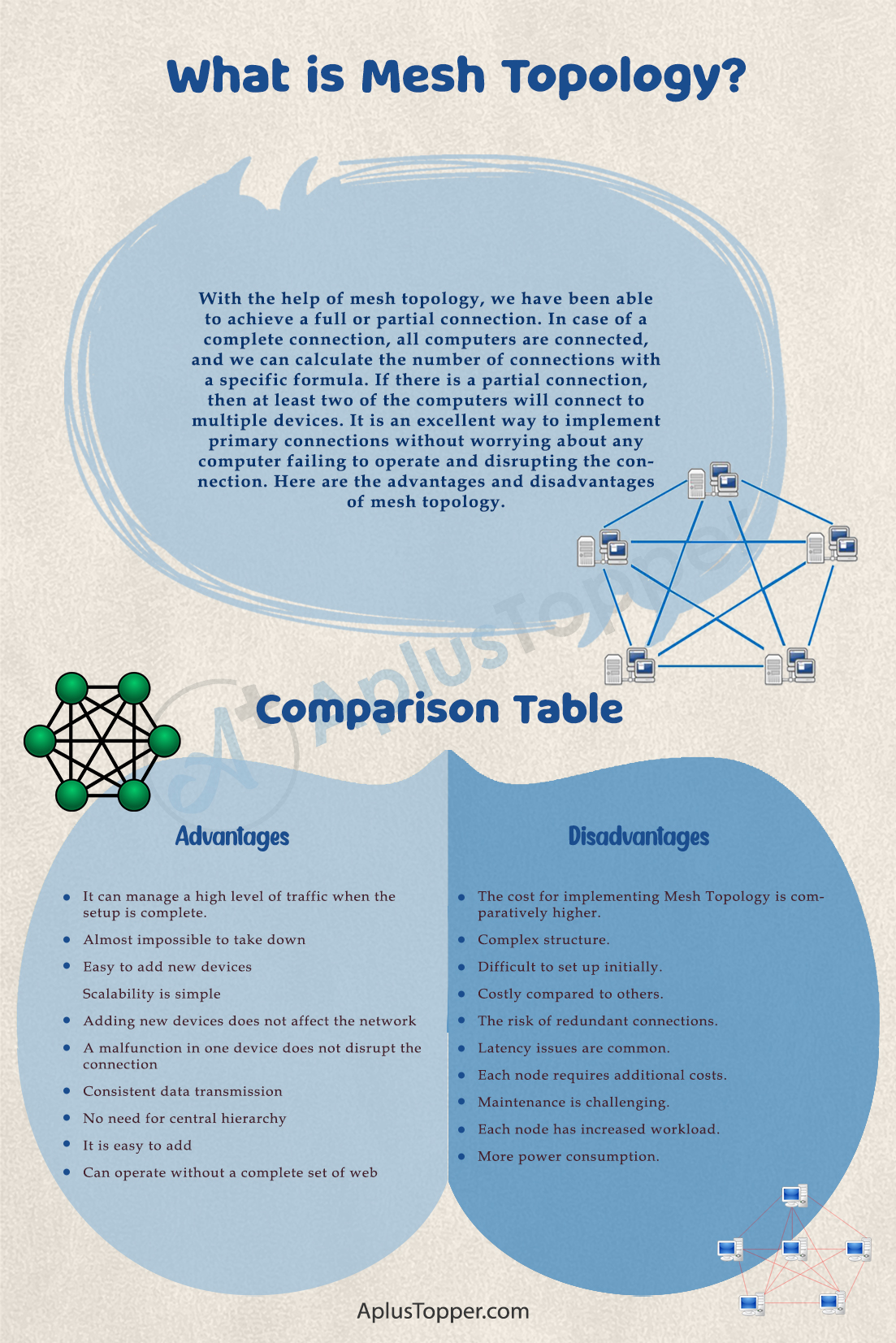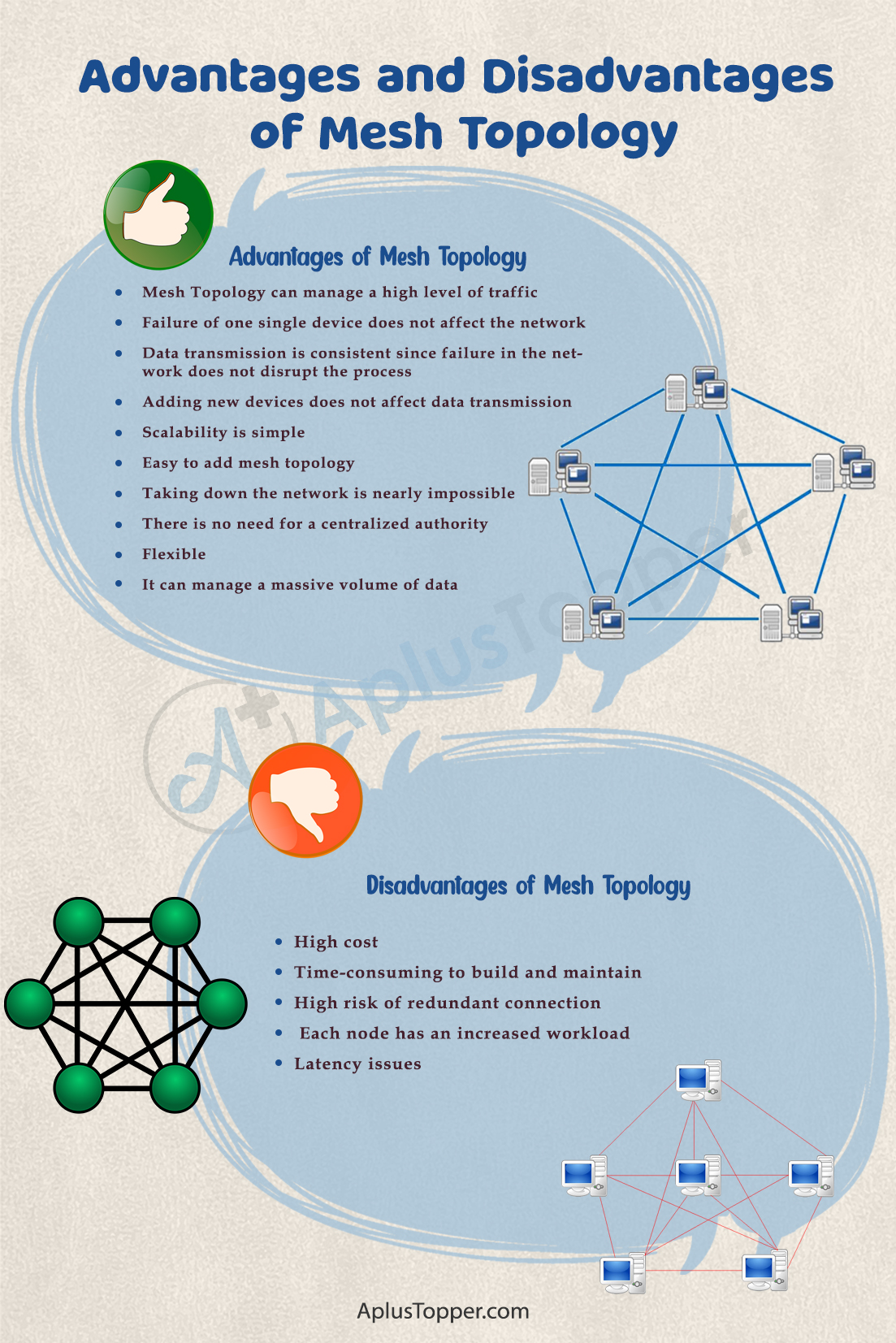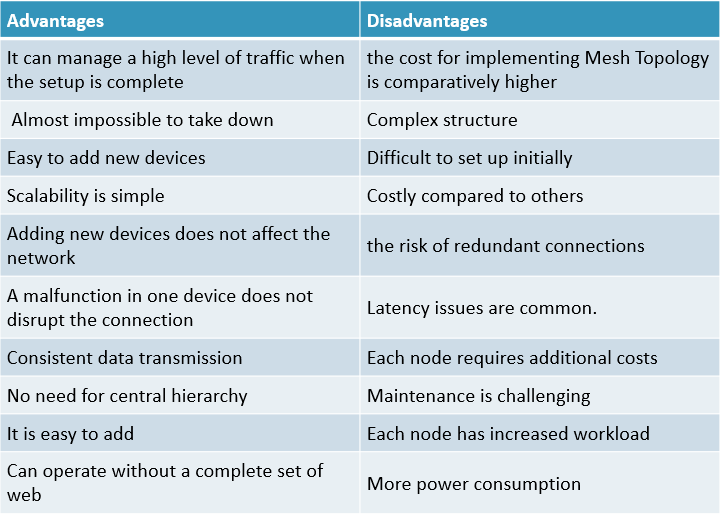Mesh Topology Advantages and Disadvantages: Mesh Topology is a kind of network setup where all the devices and the computers are interconnected. It is a structure that can connect a majority of the transmissions to be distributed if, for some reason, one of the connections fails. Mesh topology is an example of how wireless network works nowadays.
Students can also find more Advantages and Disadvantages articles on events, persons, sports, technology, and many more.
What is Mesh Topology? Advantages and Disadvantages of Mesh Topology
With the help of mesh topology, we have been able to achieve a full or partial connection. In case of a complete connection, all computers are connected, and we can calculate the number of connections with a specific formula. If there is a partial connection, then at least two of the computers will connect to multiple devices. It is an excellent way to implement primary connections without worrying about any computer failing to operate and disrupting the connection. Here are the advantages and disadvantages of mesh topology.
- Advantages of Mesh Topology
- Disadvantages of Mesh Topology
- Comparison Table for Advantages and Disadvantages of Mesh Topology
- FAQs on Pros and Cons of Mesh Topology for Students

Advantages of Mesh Topology
There are several advantages of Mesh Topology, and learning about these can help you decide how to set up the network and benefit from it.
- Mesh Topology can manage a high level of traffic: Mesh Topology does not have a hierarchical relationship. Suppose any device is connected to it and attempts to contact any other one by directly taking advantage of the routing ability of the devices. In that case, they will be able to do it.
- Failure of one single device does not affect the network: Mesh topology is exceptional when it comes to being resistant to problems. Each node of the network receives and translates information. The structure provides its users with a sufficient level of redundancy so that they can keep it running even if some malfunctions occur. If one node goes down, the network has the strength to use the other ones and complete the mesh.
- Data transmission is consistent since failure in the network does not disrupt the process: Multiple paths for data transmission are available in Mesh Topology. It requires each node to be connected to all the other ones so that the network can create a successful set of ways to operate. As a result, the overall data transmission is more consistent. Furthermore, multiple node failures do not affect the pathway and can still send a message.
- Adding new devices does not affect data transmission: Mesh Topology’s structure enables users to add new widgets to add new devices without disrupting the messages that were occurring at that time. Since every node is connected, a breakdown in one of the equipment will not disrupt the flow of information.
- Scalability is simple: Mesh topology does not require additional routers since each node acts as an individual router that allows one to change the size of the network comfortably. Hence, one can easily add new technology to any room in a corporate situation at the current speed of operation temporarily.
- Easy to add mesh topology: Usually, adding Mesh Topology is easy and goes about without any problem. One needs to connect the nodes to the gateways so that the messages can pass through to the remaining network for it to work. It allows the technology to become self-optimized.
- Taking down the network is nearly impossible: The modern structure of Mesh Topology in the world means that it is almost impossible to take it down unless there is a global disaster where all the devices we use around the globe get wiped out.
- There is no need for a centralized authority: Mesh topology does not need to incorporate a centralized control to send data. Hence, one set up an individual-based secure method of communication that lets them have the option to be anonymous if desired. They don’t need to run a firewall or other such software solutions to maintain their privacy.
- Flexible: The Mesh Topology has immense flexibility due to its partial shortfall option. Therefore, one is not forced to have a complete set of connections for each node, but the network can be built with a partial web to take advantage of the enhanced communication.
- It can manage a massive volume of data: A network with Mesh Topology can handle a tremendous volume of data compared to traditional systems since it is possible to connect multiple devices at a time and transmit data simultaneously.
Disadvantages of Mesh Topology
Though Mesh Topology has many advantages, there are some disadvantages. Knowing these can help one to understand the flip side of the coin. The disadvantages are as follows.
- High cost: The cost for implementing Mesh Topology is higher than others due to the requirement of several parts of equipment that is quite extensive. It cannot operate correctly until you have all the hardware, cabling, internet bandwidth, etc., necessary for the installation.
- Time-consuming to build and maintain: Once it is operational, adding new nodes is simple, but the initial process is complex and time-consuming.
- High risk of redundant connection: Since Mesh Topology can handle a large number of networks, there is a chance of setting redundant connections.
- Each node has an increased workload: The nodes have many responsibilities, and each one must act as a router. Hence, the system is very complex.
- Latency issues: Low power Mesh Topology does not have the processing capacity to handle data transfers in a timely manner. Hence there are plenty of latency issues.

Comparison Table for Advantages and Disadvantages of Mesh Topology
| Advantages | Disadvantages |
| It can manage a high level of traffic when the setup is complete | the cost for implementing Mesh Topology is comparatively higher |
| Almost impossible to take down | Complex structure |
| Easy to add new devices | Difficult to set up initially |
| Scalability is simple | Costly compared to others |
| Adding new devices does not affect the network | the risk of redundant connections |
| A malfunction in one device does not disrupt the connection | Latency issues are common. |
| Consistent data transmission | Each node requires additional costs |
| No need for central hierarchy | Maintenance is challenging |
| It is easy to add | Each node has increased workload |
| Can operate without a complete set of web | More power consumption |
Analyzing topics by learning their advantages and disadvantages is an excellent way to obtain knowledge. Knowing about more issues such as this will help to prepare for international competitive exams in lesser time.

FAQ’s on Pros and Cons of Mesh Topology for Students
Question 1.
How can Mesh topology handle high loads?
Answer:
The structure is such that it can efficiently manage traffic effortlessly due to the multiple nodes involved. Since there are various nodes, it can handle a high level of traffic when the setup is complete and correct.
Question 2.
Where can one use Mesh topology?
Answer:
People all around the world still use it though it is one of the oldest forms of networking. Nowadays, home automation needs, HVAC systems, and smart buildings have mesh topology.
Question 3.
Why are the nodes essential for mesh topology?
Answer:
The potential node distribution points in a building or other areas are an essential factor because there aren’t enough nodes, then linkage problems may occur while processing the messages.
